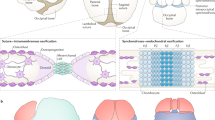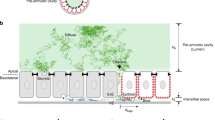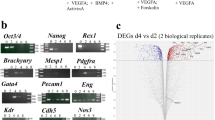Abstract
Epidermal growth factor (EGF) is a small polypeptide (6,045 molecular weight) well recognized as a mitogen affecting a variety of cell types (see refs 1–3 for reviews). Its mitogenic effect is mediated through specific high-affinity receptors on the plasma membrane, and after ligand binding, some (but not all) cells respond in a variety of ways which lead to either increased growth rate or differentiation. Although the initial description of EGF by Cohen4 demonstrated a maturational influence on eye-opening and tooth eruption in newborn mice, there has been little investigation of the effect of EGF on developing fetal tissues. Nexo et al.5 have provided evidence that EGF and its receptors are present in mouse embryos as early as day 13 of gestation, especially in the secondary palate where EGF may have a role in palate closure, and EGF receptors have also been described in the human placenta6 and in fetal rabbit lung7. Thus, the limited data available suggest that EGF may play a part in fetal growth and development of specialized function. Here, we describe the binding and mitogenic activity of EGF both in vitro and in vivo in several fetal mouse tissues.
This is a preview of subscription content, access via your institution
Access options
Subscribe to this journal
Receive 51 print issues and online access
$199.00 per year
only $3.90 per issue
Buy this article
- Purchase on Springer Link
- Instant access to full article PDF
Prices may be subject to local taxes which are calculated during checkout
Similar content being viewed by others
References
Carpenter, G. & Cohens, S. A. Rev. Biochem. 48, 193–216 (1979).
Hollenberg, M. D. Vitam. Horm. 37, 69–110 (1979).
Adamson, E. D. & Rees, A. R. Molec. cell. Biochem. 34, 129–152 (1981).
Cohen, S. Devl Biol. 12, 394–407 (1965).
Nexo, E., Hollenberg, M. D., Figueroa, A. & Pratt, R. M. Proc. natn. Acad. Sci. U.S.A. 77, 2782–2785 (1980).
O'Keefe, E., Hollenberg, M. D. & Cuatrecasas, P. Archs Biochem. Biophys. 164, 518–526 (1974).
Catterton, Z. et al. Pediat. Res. 13, 104–108 (1979).
Rees, A. R., Adamson, E. D. & Graham, C. F. Nature 281, 309–311 (1979).
Lehman, J. M., Speer, W. C., Swartzendruber, D. E. & Pierce, G. B. J. cell. Physiol. 84, 13–28 (1974).
Johnson, L. K., Baxter, J. D., Vlodavsky, I. & Gospodarowicz, D. Proc. natn. Acad. Sci. U.S.A. 77, 394–398 (1980).
Tonelli, Q. J. & Sorof, S. Nature 285, 250–252 (1980).
Covelli, I., Rossi, R., Mozzi, R. & Frati, L. Eur. J. Biochem. 27, 225–230 (1972).
Carpenter, G., King, L. & Cohen, S. Nature 276, 409–410 (1978).
Barnes, D. & Colowick, S. P. J. cell. Physiol. 89, 633–640 (1976).
Hollenberg, M. D. & Cuatrecasas, P. J. biol. Chem. 250, 3845–3853 (1975).
Fox, F. & Das, M. J. supramolec. Struct. 10, 199–214 (1979).
Bynny, R. L., Orth, D. N., Cohen, S. & Doyne, R. S. Endocrinology 95, 776–782 (1974).
Ladda, R. L., Bullock, L. P., Gianopoulos, T. & McCormick, L. Analyt. Biochem. 93, 286–294 (1979).
Sundell, H. et al. Pediat. Res. 9, 371A (1975).
Goldin, G. V. & Opperman, L. A. Eur. J. cell. Biol. 22, 388A (1980).
Hollenberg, M. D. & Cuatrecasas, P. in The Receptors Vol. I (ed. O'Brien, R. D.) 193–213 (Plenum, New York, 1979).
Dulbecco, R. & Vogt, M. J. exp. Med. 99, 167–182 (1954).
Sedmak, J. J. & Grossberg, S. E. Analyt. Biochem. 79, 544–552 (1977).
Wild, A. E. Phil. Trans. R. Soc. B271, 395–410 (1975).
Author information
Authors and Affiliations
Rights and permissions
About this article
Cite this article
Adamson, E., Deller, M. & Warshaw, J. Functional EGF receptors are present on mouse embryo tissues. Nature 291, 656–659 (1981). https://doi.org/10.1038/291656a0
Received:
Accepted:
Issue Date:
DOI: https://doi.org/10.1038/291656a0
This article is cited by
-
Neurotrophic factors for the investigation and treatment of movement disorders
Neurotoxicity Research (2003)
-
Expression of transforming growth factor alpha (TGF-α) gene in mouse embryonic development
Journal of Assisted Reproduction and Genetics (1997)
-
Immunolocalisation of epidermal growth factor (EGF), EGF receptor and transforming growth factor alpha (TGFα) during murine palatogenesis in vivo and in vitro
Anatomy and Embryology (1991)
-
Epidermal growth factor in the rat lung
Histochemistry (1991)
-
Polypeptide growth factors and the kidney: a developmental perspective
Pediatric Nephrology (1990)
Comments
By submitting a comment you agree to abide by our Terms and Community Guidelines. If you find something abusive or that does not comply with our terms or guidelines please flag it as inappropriate.



